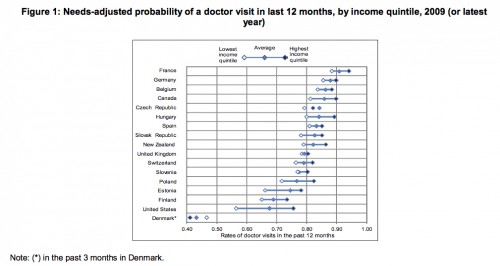Before he went on vacation, Austin pointed me to an OECD working paper, entitled “Income-Related Inequalities in Health Service Utilisation in 19 OECD Countries, 2008-2009.” I’ve found it to be quite interesting. There’s one figure I’d like to highlight for all of you:
What you are looking at is the needs-adjusted probability of having had a doctor visit in the last twelve months. For each country, the probability is shown for people in the lowest quintile of income, average income, and the highest quintile of income.
I’m going to ignore Denmark for the rest of this discussion, because for some reason the probability for that country was in the last 3 months, versus 12 months for every other country.
The first thing to note is that the average rate of a visit to the doctor varies among all these countries from a high of 91% in France to a low of 68% in the United States. Think about that the next time someone tells you how our problem is that we consume too much health care.
The second thing to note is how much variation there is between those at the upper and lower end of the economic spectrum. In the UK, for instance, there is almost no difference in utilization between the rich and the poor. All see the doctor equally. In most other countries, though, there is some inequality based on income.
None as great as the United States, though. The difference between the probability of seeing the doctor for the poor and wealthy is greater in the US than in any of the other measured countries.
People like to believe that we don’t ration care in the US. We do. More than just about any other country, we ration by cost.


